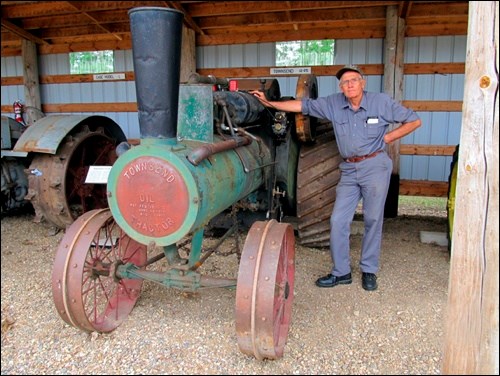A number of years ago, I was wandering around the museum grounds, snooping and starring in amazement at the endless assortment of iron monsters. One caught my eye; a small steam engine, or so it seemed. From a few yards away the fine details became visible - the "steam engine" had spark plugs and plug wires? Oops! Appearance can be deceiving - the engine was obliviously not a steamer.
Early in the last century the Townsend Company made steam engines in several sizes. About 1915 it was decided to change direction and make gasoline engines. There was a problem, however; the company had a considerable inventory of parts and some tractors near completion - thus, it was decided to do "conversions" from steam to gas.
The boilers, complete with flue, would remain intact, along with the frames and wheels. The fire box was modified to house the crank shaft and some other components of the power train. The floor of the fire box was removed to allow easy air flow through the flue. The boiler would contain cooling water. Voila! A radiator!
The steam piston and cylinder were replaced by a side-by-side two-cylinder engine with heads facing forward. A magnet was added, driven by a shaft that also activated the fuel pump. So the conversion was essentially complete from a steam engine to a gasoline (or kerosene) engine.
The Townsend retained a number of steam engine features that would make it attractive to operators who themselves were making or following the transition. As was stated earlier, the chassis, boiler and flue were the same as a steam engine. There were other features held over from steam technology.
The operating controls were essentially a "Johnson Bar." This is basically a joy stick that controlled reverse forward and clutch engagement. There is a second clutch to engage the fly wheel for belt work.
The Townsend has no radiator fan. The exhaust from the engine is expelled upwards into the exhaust stack (the forced draft flue from steam technology), air is sucked through the flue to cool the water in the "boiler/radiator." Cooling water is pumped from the "radiator" through water jackets surrounding the cylinders. Power for the water pump is delivered via a composite belt. Originally the water pump belt might have been made of heavy leather, which was common on early engines.
The Townsend is a transition machine; steam to gas. It also dragged along operators and converted them to internal combustion technology. It represents as well, one of the final steps in the move away from oxen/ horse drawn equipment - freedom from one technology, but bondage to another.
The Townsend, with all its tricks and turns, can be seen at the museum and can be seen running in the Parade of Power during Those Were The Days, Aug 11 and 12.




